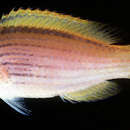en
names in breadcrumbs


The purple-lined wrasse (Cirrhilabrus lineatus), also known as the lavender wrasse, is a species of wrasse native to coral reefs of New Caledonia and Australia, where it can be found at depths from 20 to 55 m (66 to 180 ft). This species can reach a total length of 12 cm (4.7 in). It can be found in the aquarium trade.[2] As a member of the family Labridae, Cirrhilabrus lineatus displays hermaphroditic behavior where a female may become a male when it is biologically favorable to do so. Generally, this occurs when competition from larger males disappears. [3]
The purple-lined wrasse (Cirrhilabrus lineatus), also known as the lavender wrasse, is a species of wrasse native to coral reefs of New Caledonia and Australia, where it can be found at depths from 20 to 55 m (66 to 180 ft). This species can reach a total length of 12 cm (4.7 in). It can be found in the aquarium trade. As a member of the family Labridae, Cirrhilabrus lineatus displays hermaphroditic behavior where a female may become a male when it is biologically favorable to do so. Generally, this occurs when competition from larger males disappears.